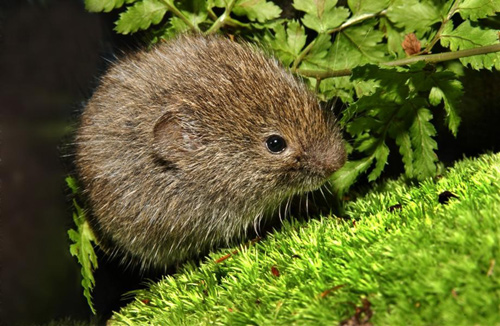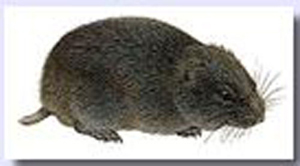Southern Bog Lemmings are found throughout Connecticut, but are elusive and rarely seen. They look a great deal like a meadow vole with brown fur and a stocky body. Southern Bog Lemmings have grooves down their front teeth that the voles lack and have shorter tails 3/4 to 1 inch in length. These lemmings weigh 3/4 to 1 3/4 oz.
Southern Bog Lemmings range through a north central to northeastern section of the continental US and through a small section of southeastern Canada. They have been listed as a species of Special Concern in Connecticut as their population seems to be low. It is believed they are being pushed out of their Connecticut habitats by meadow voles. Their favorite habitat is in areas where grasses and sedges are growing. Such habitat is provided by sphagnum bogs, but lemmings also live in meadows, cleared forest areas, orchards, and open grassland. They are active all year and during both daytime and nighttime.
Southern Bog Lemmings eat grasses, sedges, and clover. They will also sometimes eat mosses, fungi and insects.
The droppings of the Southern Bog Lemming differentiate it from other common rodents with which it may share habitat such as mice, shrews and voles. Bog Lemming droppings are bright green oval pellets. Another common sign of bog lemmings is piles of grass clippings about an inch long.
These lemmings mate from early spring to late autumn in this region, although in warmer climates breeding may be year round. Several litters are produced a year and may contain 1-8 babies. Nesting chambers can be an underground, but in warm months the nest used for raising young may be above ground in a clump of grass or other cover.
Bog lemmings make extensive underground tunnels 6 to 12 inches under the surface. Their tunnel systems contain multiple chambers where lemmings can rest, eat, and store food. The tunnels are often shared with other small rodents. Lemmings live in colonies that are often temporary. They tend to move slowly, except when responding to danger, and can swim.
Neat Fact
Lemmings do not commit mass suicide. Some types of lemming, notably the Norway Lemming of Russia and Scandinavia, undergo population cycles and during cycles of very high population pressure may have to move to new areas in large numbers. In the process of travel the lemmings may try to cross bodies of water that are too large to swim across and therefore drown accidentally. It is believed this behavior is the source of the popular lemming-suicide belief. The Southern Bog Lemming of Connecticut is not subject over-population, quite the opposite.

